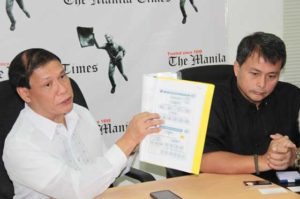The Metropolitan Manila Development Authority (MMDA) has only one solution to the monstrous traffic jams along the 54-kilometer Epifanio de los Santos (EDSA) – divert a big volume of motorists to the Mabuhay lane, especially during the Christmas season.
Drastic and costly solutions like bus rapid system (BRS), odd-even scheme, subway, relocation of government agencies, banning cars with fewer than three passengers, or modular steel bridges are not needed to fight the carmageddon along EDSA, according to Manuel Gonzales, a retired military general who now heads the MMDA Security Investigation and Intelligence Office.
“All we need is to implement the laws like the three-meter easement, illegal parking, illegal terminal, and sidewalk vendors. Once this Mabuhay lane has been freed of all obstruction, then motorists will eagerly pass it,” Gonzales told editors of The Manila Times.
However, to remove obstructions, impose single ticketing and have one head to direct all traffic in Metro Manila, Congress will need to pass a legislation giving the President emergency powers, he said.
The MMDA said it needs 10,000 force-multiplier traffic enforcers to complete the 18,000 personnel needed.
At present, the agency has 8,000 traffic enforcers.
Gonzales said the government has created an Inter-Agency Coordinating office led by an undersecretary of the Department of Transportation. The IAC is in charge of traffic operations and has operational control over the MMDA, Highway Patrol Group, Land Transport Office and the Land Transportation Franchising and Regulatory Board.
Cesar Ona Jr., MMDA deputy director, said the Metro Manila Council, composed of the mayors of the local government units in Metro Manila, has passed resolutions imposing the “nose in, nose out” of provincial buses and the elimination of pedicabs, pushcarts, tricycles, and ‘kuliglig’ along Mabuhay lane.
Ona added that MMDA is working on major projects that will have major impact in easing traffic congestion like the clearing of big trucks in Delpan, Manila and the transfer of informal settlers.
Crisanto Saruca Jr. meanwhile said there are some illegal terminals which they could not touch because they are being protected by powerful officials. He, however, refused to identify them.
Aside from Mabuhay lanes, another alternative is the Pasig River ferry system. The MMDA is operating 12 ferryboats and 11 stations with a capacity of 200 to 400 daily passengers. Ona said they are adding more stations in Marikina City to attract at least 1,000 passengers daily.
Aside from discipline on the part of motorists, pedestrians, what the government needs to improve the traffic situation along EDSA is the “emergency power” that will centralize enforcement and resolve conflicts arising from the traffic ordinances issued by LGUs.


